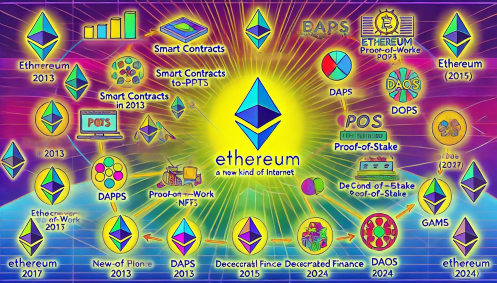
Ethereum, conceptualized in 2013 and launched in 2015 by Vitalik Buterin and a group of like-minded developers, is more than just a cryptocurrency—it’s a platform for creating decentralized applications (dApps). Unlike Bitcoin, which was designed primarily as a digital alternative to traditional currencies, Ethereum aims to use blockchain technology to replace internet third parties — those that store data, transfer mortgages, and keep track of complex financial instruments.
The core innovation that Ethereum introduced is the “smart contract.” Smart contracts are programs stored on the blockchain that run when predetermined conditions are met. They are executed by the blockchain, which results in an outcome that cannot be reversed or tampered with. This automation of contracts and agreements allows developers to create applications that are not only decentralized but also immutable and secure. The potential applications range from financial services and crowdfunding to new organizational structures and voting systems, making Ethereum a groundbreaking technology that extends beyond the financial use cases of blockchain.
In the early days, Ethereum quickly gained traction among developers due to its potential for a wide range of applications. The initial coin offering (ICO) craze of 2017, where funds were raised in cryptocurrencies for new projects and startups, often built on Ethereum, underscored its popularity. However, the platform was not without its challenges. In 2016, a hack known as the “DAO attack” exploited vulnerabilities in a smart contract, leading to the theft of approximately $50 million worth of Ethereum’s currency, ether. This event led to a contentious decision and resulted in Ethereum being split into two separate blockchains, Ethereum (ETH) and Ethereum Classic (ETC), with the former adopting a new blockchain to reverse the effects of the hack.

Ethereum’s roadmap includes several protocol upgrades, known as Ethereum 1.x, which aim to improve the system’s scalability, security, and sustainability. These include transitioning from proof-of-work (PoW) to proof-of-stake (PoS) in its consensus algorithm, significantly reducing the energy consumption of the network. This shift, part of the Ethereum 2.0 update, aims to address the network congestion and high transaction fees experienced during periods of high demand.
The introduction of features like sharding (which splits the database to spread the load) and the layer 2 scaling solutions (like rollups that execute transactions outside the main Ethereum chain but post transaction data on-chain) are part of these upgrades, intending to increase transaction throughput and reduce costs.

As of 2024, Ethereum has not only established itself as the leading platform for dApps and smart contracts but has also spurred a significant evolution in how blockchain technology is viewed and utilized. The network hosts a wide array of applications, from decentralized finance (DeFi) and non-fungible tokens (NFTs) to games and decentralized autonomous organizations (DAOs). Each of these uses leverages Ethereum’s open-source, public blockchain that is not controlled by any single entity, making it a foundational layer for a new kind of internet.
While Ethereum continues to face challenges, including those related to scalability and security, its community remains one of the most active and innovative in the cryptocurrency space. Ethereum’s ongoing development and the commitment of its community suggest that it will continue to play a significant role in defining the future of blockchain technology and digital transactions. Whether it becomes the standard platform for decentralized applications or one of many significant players, Ethereum’s impact on technology and finance is undeniable.